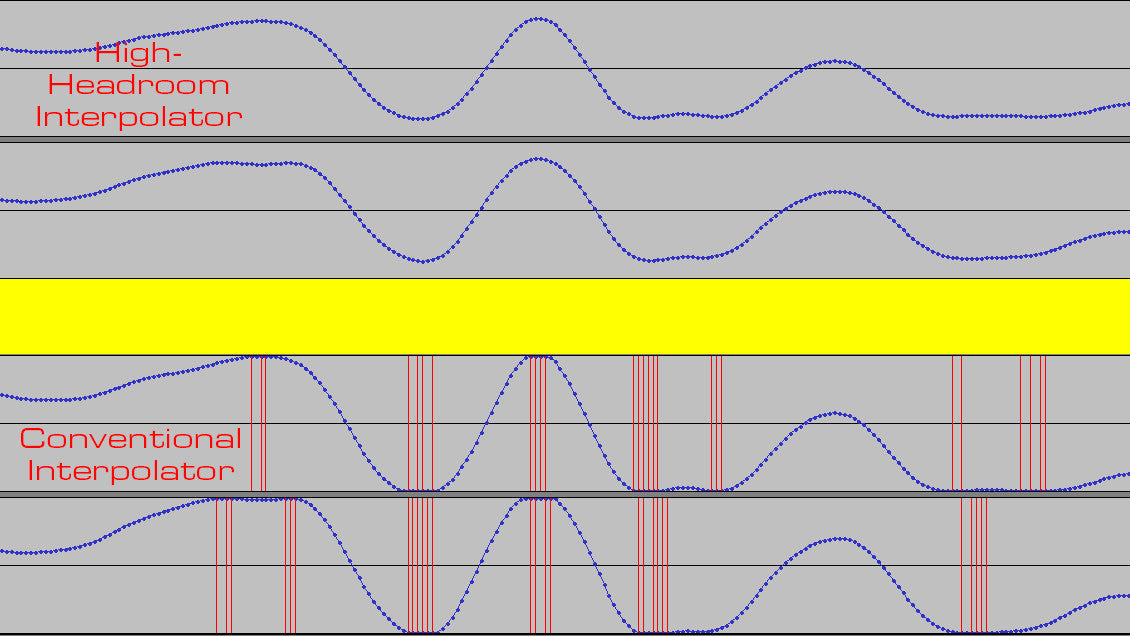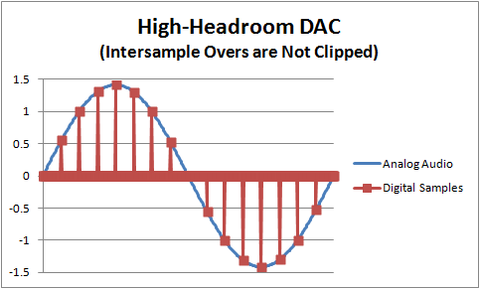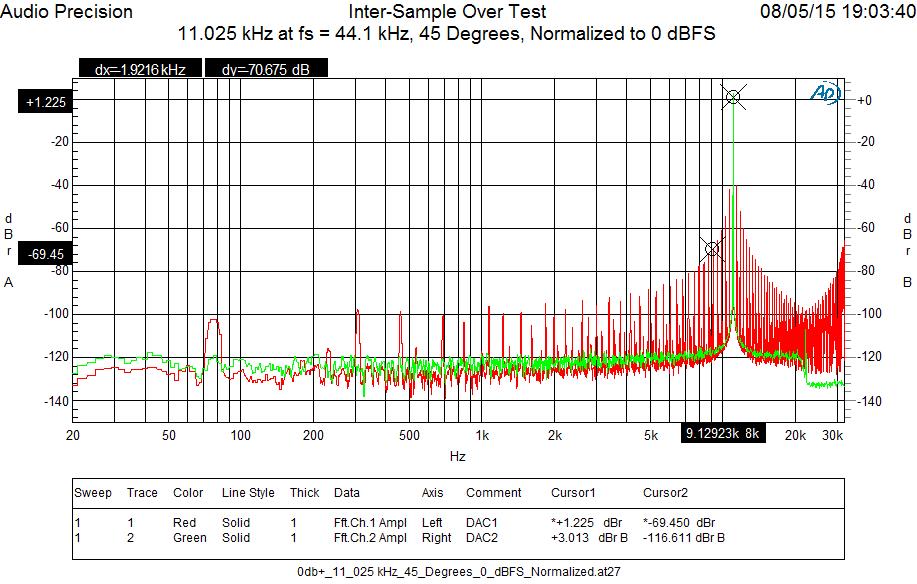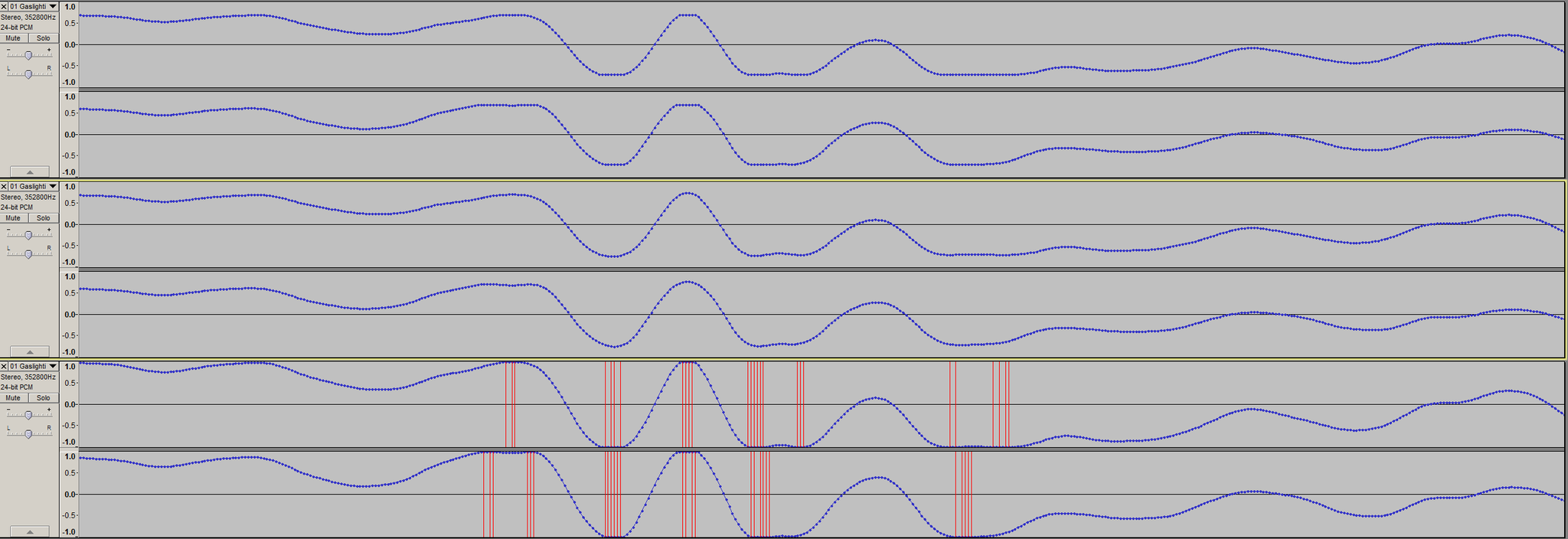Buy one component and save 10% on up to 2 cables. Buy 2 components and get 4 free cables. Free shipping on USA orders over $700.
Buy one component and save 10% on up to 2 cables. Buy 2 components and get 4 free cables. Free shipping on USA orders over $700.
Intersample Overs in CD Recordings
by John Siau February 10, 2017
Intersample Overs are a Common Occurrence in CD Recordings
We have frequently used Steely Dan's Gaslighting Abbie from Two Against Nature in our listening tests. This is a spectacular CD recording with lots of dynamics and a low noise floor. Nevertheless, in a little over 5 minutes, this track has 559 intersample overs on the left track and 570 on the right track for a total of 1129. This means that there are about 3.7 intersample overs per second. The highest intersample over measures +0.8 dBFS. The track itself is not clipped, the 44.1 kHz sampling has simply captured peaks that exceed 0 dBFS. The image above shows the track with the intersample overs highlighted in red.
If we zoom in on this track we can see the what the track should look like without clipping (using a high-headroom interpolator) and we can see what it looks like when rendered with a conventional interpolator (such as those found in most oversampled D/A converters). The vertical red lines have been added to show where clipping occurred in the conventional interpolator.

When newer technologies are properly applied, the CD can deliver stunning results that closely rival the high-resolution formats. A significant improvement can be gained through the use of high-headroom interpolators in D/A and SRC devices. This paper shows how intersample peaks can be reconstructed and rendered without clipping.
History
The Compact Disc (CD) was introduced in 1982. Thirty five years later, the 44.1 kHz 16-bit CD audio format is still the most popular digital format. In spite of the push for high-resolution audio formats, the vast majority of new recordings are only released in this format (or in files derived from this format).
Basic Limitations of the CD Format
The CD format delivers a DC to 22 kHz frequency response and about a 96 dB signal to noise ratio. In 1982, the 44.1 kHz sample rate and 16-bit word length were selected to match the limitations of the human ear, the limitations of transducers, and the limitations of typical recording and playback environments. At that time, the 16-bit word length exceeded the capabilities of converters by about 2 bits. Anything beyond 16 bits would have seemed unreasonable in 1982.
The Move to High-Resolution Audio Components
In recent years, converters, power amplifiers, and transducers have improved significantly. For example, the Benchmark DAC3 converters and AHB2 power amplifiers achieve A-weighted signal to noise ratios ranging from 128 dB to 132 dB. This is equivalent to the performance of a 21 to 22 bit digital system. Components of this quality justify a move to high-resolution formats, but most listeners will find that the vast majority of their favorite tracks are still only available in CD format.
Extending the Performance of the CD Format
Fortunately, we have learned how to extract more performance from the CD format. Newer recordings use noise-shaped dither to reduce the 16-bit quantization noise to a level that is equivalent to that of a 20-bit format. Oversampling converters with specialized filters have improved the high-frequency performance in the region between 18 kHz and 22 kHz while reducing distortion at all frequencies. These oversampling converters can also accurately reconstruct the original analog waveform between samples.
These spectacular improvements have brought the theoretical performance of the 35 year old CD format very close to that of the new high-resolution formats. Old recordings benefit from the improvements in D/A converters and power amplifiers. Newer recordings add the the benefits of the noise shaping and improved A/D conversion used to produce the recordings.
Audible Artifacts Remain
When all of these newer technologies are properly applied, the CD can deliver stunning results that closely rival that of the high-resolution formats. In theory, the frequency response and noise performance of the best CD recordings should be good enough to eliminate any and all audible defects related to the limitations of the 44.1 kHz 16-bit PCM system. Unfortunately, this theory is an oversimplification. Here at Benchmark, we believe that most oversampling D/A converters produce audible artifacts when playing 44.1 kHz recordings. These artifacts are caused by inadequate headroom in the oversampling interpolation filters. Fortunately, this artifact is preventable.
Oversampling Exposes Intersample Peaks
PCM digital systems sample audio waveforms at discrete instances in time. Samples may occur at a waveform peak, but in most cases, the samples will miss the peaks. The diagram below shows an analog waveform being sampled by a digital system. "1" and "-1" represent the maximum and minimum digital codes. In a 16-bit system, these codes would be +32,767 and - 32,768. In the diagram below, note that the peaks exceed the maximum and minimum codes by a factor of 1.414 (3.01 dB). This worst-case example occurs when the audio tone is 1/4 of the sample rate. In a 44.1 kHz system, this worst-case scenario occurs near 11 kHz. High sample rate systems are much less prone to this problem because the worst-case occurs at ultrasonic frequencies where there is very little audio content.

If the digital samples are interpolated to a high sample rate (as is done in oversampled D/A converters) the resulting samples typically look like this:

In the above diagram, the interpolator in the oversampled D/A converter produces a severely clipped sine wave when attempting to reproduce the original analog waveform. Some D/A converters will produce additional distortions that are caused by numeric overflows in the digital signal processing. In either case, these conventional oversampled D/A converters produce bursts of distortion whenever intersample overs occur. Please note that SRC and ASRC devices (sample rate converters) use interpolators and these have similar overload problems. In our opinion, the audible signature of many SRC and ASRC chips can be attributed to this overload problem.
Faulty D/A and SRC Chips
Every D/A chip and SRC chip that we have tested here at Benchmark has an intersample clipping problem! To the best of our knowledge, no chip manufacturer has adequately addressed this problem. For this reason, virtually every audio device on the market has an intersample overload problem. This problem is most noticeable when playing 44.1 kHz sample rates.
High-Headroom Interpolation
It is possible to build interpolators that will not clip or overload, but this is not being done by the D/A and SRC chip manufacturers. For this reason, Benchmark has moved some of the digital processing outside of the D/A chip. In the Benchmark DAC2 and DAC3 converters we have an external interpolator that has 3.5 dB of headroom above 0 dBFS. This means that the worst-case +3.01 dBFS intersample peaks can be processed without clipping. We also drive the ESS D/A converter chips at -3.01 dB so that no clipping will occur inside the ES9018 and ES9028PRO converter chips. The results are represented in the following diagram:

Proof that it Works
If we run a spectrum analysis of the output of a conventional D/A converter and a high-headroom D/A converter we can see the difference:
The green trace was produced by a high-headroom Benchmark DAC2. The DAC2 correctly reproduced an 11.025 kHz sine wave having an amplitude of +3.01 dBFS. The red trace shows the output of the Benchmark DAC1 under the same test conditions. Like most products on the market, the older DAC1 uses conventional interpolation and it will overload whenever intersample peaks exceed 0 dBFS. Note that the red plot shows many distortion products that are not harmonically related to the 11.025 kHz tone. These IMD (intermodulation distortion) products are produced by interactions between the test tone, the sampling frequency, and the oversampling frequency. This IMD distortion is not musical and does not occur in analog systems. It produces a sound that is unique to digital systems. Note that most of the distortion occurs between 5 kHz and 22 kHz. This can produce a false brightness or brittleness when overloads occur. This begs the question; how often do intersample overs occur?
Intersample Overs are a Common Occurrence in CD Recordings
We have frequently used Steely Dan's Gaslighting Abbie from Two Against Nature in our listening tests. At trade shows, it is not unusual to hear this track being played. This is a spectacular CD recording with lots of dynamics and a low noise floor. Nevertheless, in a little over 5 minutes, this track has 559 intersample overs on the left track and 570 on the right track for a total of 1129. This means that there are about 3.7 intersample overs per second. The highest intersample over measures +0.8 dBFS. The track itself is not clipped, the 44.1 kHz sampling has simply captured peaks that exceed 0 dBFS. Of the 1129 overs, a total of 993 intersample peaks measure at least +0.5 dBFS. The following image shows the track with the intersample overs highlighted in red:
Example 1 - Two Against Nature, Gaslighting Abbie, Steely Dan
As stated above, this track has 1129 intersample overs, but the track itself is not clipped. This intersample overs contain dynamics that can be recovered accurately if they are rendered with a high-headroom interpolator.
Unfortunately these dynamic peaks that were captured in the recording process, cannot be rendered by most D/A converters. These peaks will overload conventional interpolators and each over will be rendered as a burst of percussive noise. On this track, an overloaded interpolator tends to add a false brightness to the snare drum while changing its sound.
Benchmark DAC2 and DAC3 converters are among the very few converters that have high-headroom interpolators. These converters accurately render the intersample peaks that were captured in the recording process. This dynamics of this track can only be fully appreciated when it is rendered without clipping.
Test Methodology
To arrive at these counts we reduced the amplitude by 3 dB and then applied 8X interpolation to render the intersample peaks without clipping. Working at the 8X (352.8 kHz) sample rate, we then measured the amplitudes of the reconstructed intersample peaks. Next we restored the track to its original amplitude by increasing the gain by 3 dB. This allowed us to highlight the 1129 intersample overs in red. We used Audacity to perform these functions.
Zooming In
The following segment from Gaslighting Abbie compares conventional interpolation to high-headroom interpolation. The top two tracks were 8X interpolated with a conventional interpolator. The middle two tracks were 8X interpolated with a high-headroom interpolator. Note how the peaks were properly rendered by the high-headroom interpolator. The bottom two tracks show where the clipping occurs in the conventional interpolator. The segment starts at 2:30.46880 and ends at 2:30.47015 seconds, and is typical of many of the intersample overs contained in this recording.
Please note that the 44.1 kHz CD sample rate captured the intersample peaks. When high-headroom interpolation was applied, the original peaks contained in the music were recovered and accurately rendered. This high-headroom interpolation technique delivers an accurate rendition of the analog signal captured by the A/D converter in the studio.
Intersample Overs are a Common Occurrence in CD Recordings
Intersample overs are not unique to the Gaslighting Abbie track or to Steely Dan's Two Against Nature CD. Most CD recordings contain intersample overs.
More Examples
Here are some other examples of tracks with intersample peaks that exceed 0 dBFS:
Example 2 - Two Against Nature, What a Shame About Me, Steely Dan
Intersample overs are shown in red, highest intersample peak = +0.486 dBFS
Example 3 - Two Against Nature, Janie Runaway, Steely Dan
Intersample overs are shown in red, highest intersample peak = +0.565 dBFS.
Example 4 - Begin to Hope, Fidelity, Regina Spektor
Intersample overs are shown in red, highest intersample peak = +1.49 dBFS. This track has most of the intersample overs concentrated in the right channel. They seem to be caused by percussion that is slightly panned to the right.
Example 5 - Daft Punk, Get Lucky (88.2 kHz Original)
Intersample overs are shown in red, highest intersample peak = +0.485 dBFS.
Note: This is an 88.2 kHz recording that has been hard limited to -0.01 dBFS. The limiting produces intersample overs when interpolating 4X to 382.8 kHz. This means that a conventional interpolator would add distortion at the peaks shown in red.
Example 6 - Raising Sand, Rich Woman, Alison Krauss and Robert Plant
The following CD track is loud but, surprisingly, it has no intersample overs. It was mastered by Gavin Lurssen in 2007. This track demonstrates that it is possible to create CDs without intersample overs, although this should not be necessary if converters and SRC devices have high-headroom interpolators.
Leave a comment
Comments will be approved before showing up.
Also in Audio Application Notes

How Loud is the Distortion from Your Power Amplifier?
by John Siau August 08, 2025
Would you put a Washing Machine in your Listening Room?
If the answer is no, you may be surprised to discover that the distortion produced by your power amplifier may be louder than the noise produced by a major appliance.
Don't believe me? Take a look at Stereophile's test reports:
We selected 7 power amplifiers from Stereophile's top list of recommended amplifiers.
We took Stereophile's "THD+N vs. Power" plots for each, and replotted the data in a format that shows the loudness of the THD+N at the listening position.
The results are shocking!
Amplifier THD+N is louder than expected!
The distortion from your amplifier may be louder than a washing machine on the spin cycle, or it may be totally silent. How does yours perform? The answer is hidden in Stereophile's THD+N plots.
This application note reveals the hidden truth:
"The Distortion from your Power Amplifier may be Louder than a Washing Machine!"
I know, it sounds crazy, but this is what the measurements show!

Interpolator Overload Distortion
by John Siau November 20, 2024
Most digital playback devices include digital interpolators. These interpolators increase the sample rate of the incoming audio to improve the performance of the playback system. Interpolators are essential in oversampled sigma-delta D/A converters, and in sample rate converters. In general, interpolators have vastly improved the performance of audio D/A converters by eliminating the need for analog brick wall filters. Nevertheless, digital interpolators have brick wall digital filters that can produce unique distortion signatures when they are overloaded.
10% Distortion
An interpolator that performs wonderfully when tested with standard test tones, may overload severely when playing the inter-sample musical peaks that are captured on a typical CD. In our tests, we observed THD+N levels exceeding 10% while interpolator overloads were occurring. The highest levels were produced by devices that included ASRC sample rate converters.

Audiophile Snake Oil
by John Siau April 05, 2024
The Audiophile Wild West
Audiophiles live in the wild west. $495 will buy an "audiophile fuse" to replace the $1 generic fuse that came in your audio amplifier. $10,000 will buy a set of "audiophile speaker cables" to replace the $20 wires you purchased at the local hardware store. We are told that these $10,000 cables can be improved if we add a set of $300 "cable elevators" to dampen vibrations. You didn't even know that you needed elevators! And let's not forget to budget at least $200 for each of the "isolation platforms" we will need under our electronic components. Furthermore, it seems that any so-called "audiophile power cord" that costs less than $100, does not belong in a high-end system. And, if cost is no object, there are premium versions of each that can be purchased by the most discerning customers. A top-of-the line power cord could run $5000. One magazine claims that "the majority of listeners were able to hear the difference between a $5 power cable and a $5,000 power cord". Can you hear the difference? If not, are you really an audiophile?









